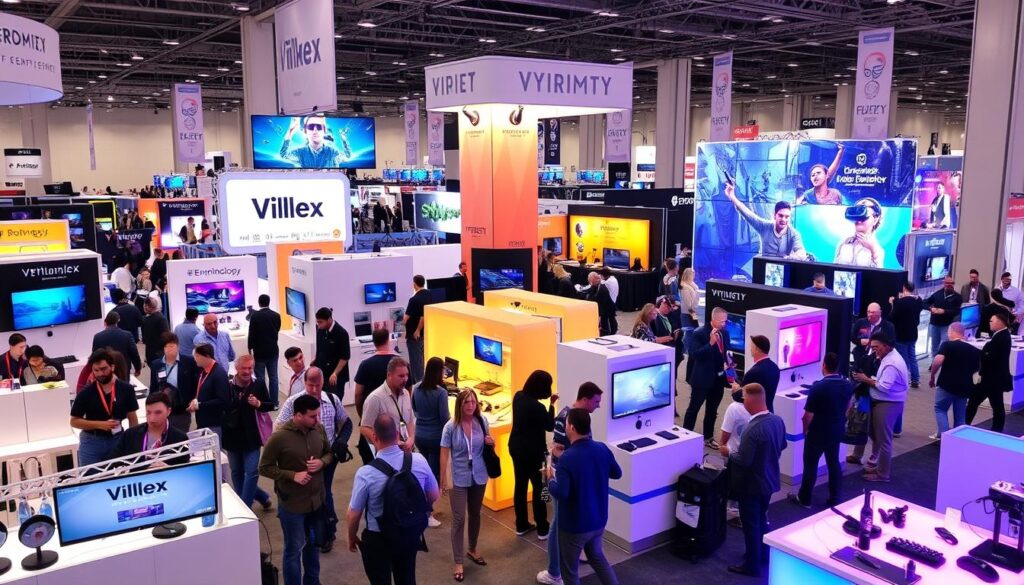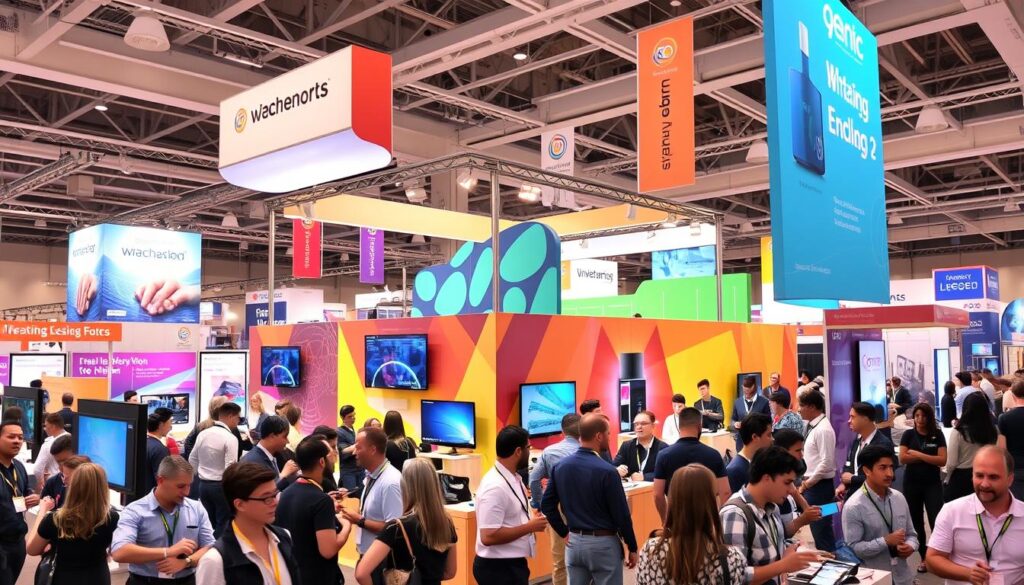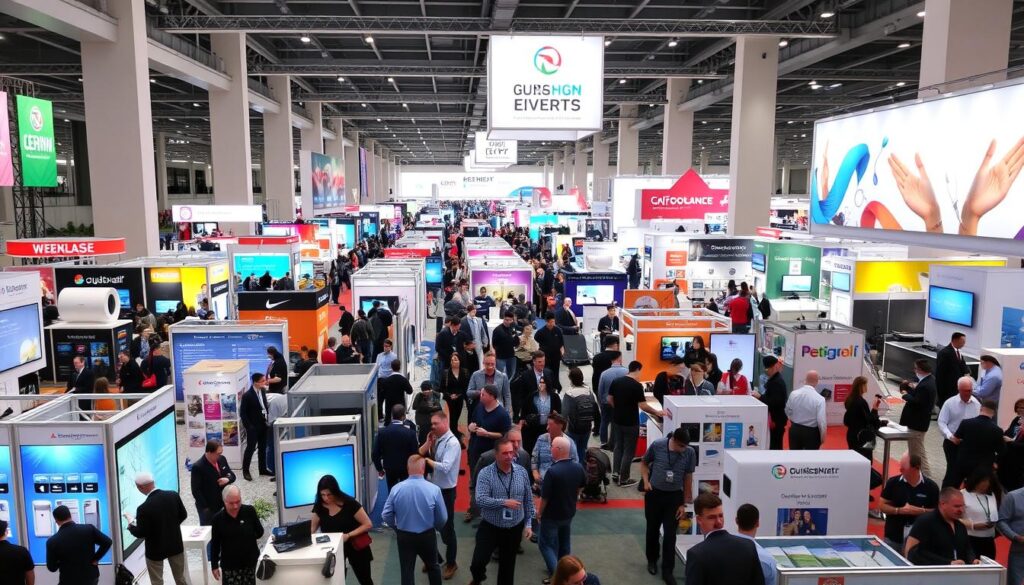Trade shows offer businesses a powerful way to showcase products and connect with customers. With many exhibitors competing for attention, creating a standout exhibit is crucial. This guide provides essential tips for planning a successful trade show presence.
We’ll cover crafting a compelling strategy and designing an eye-catching booth. You’ll also learn how to maximize visitor engagement and measure your trade show success.
Key Takeaways
- Develop a clear trade show strategy aligned with your business goals and target audience
- Design an eye-catching booth that effectively communicates your brand and offers a memorable experience
- Engage visitors through interactive displays, knowledgeable staff, and valuable content
- Leverage marketing tactics, both digital and traditional, to promote your trade show presence
- Measure the success of your trade show participation by tracking leads, sales, and return on investment
Crafting a Compelling Trade Show Strategy
A strong trade show strategy is key to a successful exhibit. Start by setting clear goals for your participation. These goals will guide your planning and align with your business objectives.
Defining Your Goals and Objectives
Consider these factors when setting trade show goals:
- Lead generation: How many new leads do you hope to acquire?
- Brand awareness: What message do you want to convey about your brand?
- Product launches: What new offerings do you plan to showcase?
- Sales: What revenue or sales targets do you hope to achieve?
Clear goals will help you create a focused and impactful strategy. Your exhibit will be more effective with well-defined objectives.
Understanding Your Target Audience
Research your target audience thoroughly for a successful trade show presence. Understand their pain points, preferences, and buying habits. This knowledge will help your exhibit resonate with them.
Develop buyer personas to gain deeper insights into your ideal attendees. Use these insights to tailor your messaging and activities.
Align your strategy with your goals and target audience. This approach will create a compelling exhibit that stands out. Your engagement with attendees will be more meaningful and effective.
Designing an Eye-Catching Trade Show Booth
Your trade show booth is the heart of your exhibit. It must attract and engage visitors effectively. Your brand’s visual identity should be front and center.
Logos, colors, and messaging create a cohesive presence. A well-planned layout encourages visitor flow and interaction. Interactive displays, product demos, and cozy seating areas enhance the experience.
Incorporating Branding Elements
Consistency is crucial in your trade show booth design. Align your booth’s visuals with your brand identity. This includes graphics, colors, and typography.
A familiar look builds trust with your audience. It makes your booth more memorable and engaging.
Creating an Engaging Layout
- Develop a strategic booth layout that guides visitors through your exhibit, encouraging them to explore and interact with your products or services.
- Incorporate interactive elements, such as touchscreen displays or product demonstrations, to capture attendees’ attention and foster meaningful conversations.
- Provide comfortable seating areas where visitors can rest and engage with your team, fostering a welcoming and inviting atmosphere.
| Element | Benefit |
|---|---|
| Branding | Enhances brand recognition and creates a cohesive visual identity |
| Interactive Displays | Increases visitor engagement and facilitates lead generation |
| Comfortable Seating | Encourages attendees to spend more time at your booth and build relationships |
A well-designed trade show booth can make a big impact. It showcases your brand effectively. It also drives meaningful interactions with potential customers.
Trade Shows: Maximizing Visitor Engagement
Your trade show booth needs more than just a great design. It requires engaging experiences that captivate attendees. Interactive elements like product demos, games, or hands-on activities can forge deeper connections with potential customers.
Train your booth staff to be knowledgeable and approachable. Their skills in starting meaningful conversations can leave lasting impressions. This approach can drive potential leads and create memorable interactions.
To boost trade show visitor engagement, add interactive experiences to your booth activities. Consider using interactive displays, virtual reality demos, or gamified experiences. These elements encourage visitors to engage with your products in fun ways.
| Interactive Booth Experiences | Benefits |
|---|---|
| Product Demonstrations | Allows visitors to see your products in action and understand their features and capabilities. |
| Interactive Games or Challenges | Engages visitors in a fun and memorable way, encouraging them to spend more time at your booth. |
| Virtual Reality (VR) Experiences | Provides a unique and immersive way for visitors to interact with your products or services. |
Engaging and interactive experiences can maximize visitor engagement at your trade show booth. This approach leads to productive conversations and qualified leads. Ultimately, it contributes to a successful event overall.

Promoting Your Trade Show Presence
Effective pre-show marketing is key to success at trade shows. It helps attract attendees and generate buzz around your brand. A mix of social media and traditional tactics can build anticipation and drive traffic to your exhibit.
Leveraging Social Media
Social media platforms offer powerful ways to promote your trade show presence. Use LinkedIn, Twitter, and Instagram to share sneak peeks and highlight special offers. Engage with attendees in real-time and participate in industry-related conversations.
Use relevant hashtags to increase your visibility. Encourage your team to actively participate in online discussions about the event.
- Create a social media content calendar to plan and schedule your pre-show posts
- Leverage video content to give attendees a behind-the-scenes look at your booth setup
- Engage with attendees by responding to comments and questions on your social channels
Traditional Marketing Tactics
Traditional tactics can still be effective in driving trade show promotion. Consider a targeted email campaign to reach your existing customer base. Invite them to visit your booth at the event.
Explore print advertising in industry publications or direct mail. These methods can help reach a wider audience and encourage pre-show registration.
| Marketing Tactic | Benefit |
|---|---|
| Email Campaigns | Reach your existing customer base and encourage booth visits |
| Print Advertising | Increase visibility and drive pre-show registration |
| Direct Mail | Engage a wider audience and stand out in the crowded trade show landscape |
Combining trade show promotion, social media marketing, and traditional marketing creates a strong pre-show strategy. This approach sets the stage for a successful and well-attended trade show presence.

Trade Show Logistics and Planning
Trade show success hinges on careful planning and logistics. Organizers must budget for all costs, including booth rental and travel. A detailed timeline ensures smooth execution from setup to follow-up.
Budgeting and Cost Management
Smart budgeting is key for a winning trade show campaign. Businesses should plan for these expenses:
- Booth rental fees
- Travel and accommodation costs for staff
- Shipping and transportation of booth materials and products
- Promotional materials and giveaways
- Additional services, such as internet access, electricity, or catering
Anticipating costs helps ensure a smooth trade show experience. By allocating resources wisely, organizations can stay financially responsible.
| Expense Category | Average Cost |
|---|---|
| Booth Rental | $2,000 – $10,000 |
| Travel and Accommodation | $500 – $1,500 per staff member |
| Shipping and Transportation | $500 – $2,000 |
| Promotional Materials | $500 – $2,000 |
| Additional Services | $200 – $1,000 |
Thoughtful planning and budgeting lead to successful trade shows. This approach ensures organizations get the most value from their participation.

“Proper planning and cost management are the keys to maximizing the return on investment from a trade show.”
Measuring Trade Show Success
Tracking trade show success is vital for justifying costs and planning future strategies. Set key performance indicators (KPIs) to measure lead quantity, quality, and conversions. This data helps evaluate your investment’s effectiveness.
Analyze your results to determine your return on investment (ROI). Look at lead-to-sale conversion rates and average deal size. These insights will help you improve your trade show strategy.
Careful measurement shows the real impact of your trade show presence. Use this data to make smart changes for your next event. This approach ensures better results and maximizes your investment.

